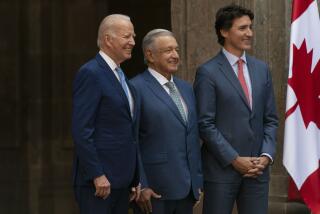International Business : Where the Professions Stand With NAFTA
- Share via
ISSUE: The North American Free Trade Agreement was designed to ease barriers to trade in services as well as in goods among Canada, Mexico and the United States. But architects, doctors, lawyers and other professionals won’t be hanging out their shingles across borders anytime soon.
All three countries must first agree on mutually acceptable professional qualifications, licensing standards and accreditation of professional schools. Although some U.S. professional groups report progress in recent meetings with their Mexican and Canadian counterparts, the process could take years.
BACKGROUND: NAFTA eliminated restrictions that kept professionals from practicing in the neighboring countries on the basis of citizenship or residency. The NAFTA ideal was “portability of credentials”--that is, U.S. professionals could practice in Canada and Mexico, and vice versa, as long as they met mutually acceptable qualifications.
Long before NAFTA, U.S. professionals had been practicing in Canada and Mexico as consultants, often acting in concert with foreign firms they partly owned or with which they had formed professional alliances. The Bechtel engineering firm and the Deloitte & Touche accounting firm, for example, have offices worldwide.
Why pursue professional reciprocity, then? Take architecture, for example. The real responsibility--and big fees--come from being the architects of record for a given project. Before NAFTA it was impossible for U.S. firms in Mexico or Canada to have that status, said Jim Scheeler, resident fellow for international relations at the American Institute of Architects in Washington, D.C.
For Mexico to comply with the professional provisions in NAFTA required an amendment to its constitution, which before had stipulated that only citizens could practice certain professions.
Some U.S. professional groups took a defensive approach to NAFTA. The American Medical Assn., for example, supported the agreement only after getting assurances that its provisions would not reduce standards, allowing unqualified Canadians and Mexicans to practice here, an AMA spokesman said.
But most groups saw only opportunities in NAFTA. “Our view was NAFTA was good for business and trade, and what is good for international business and trade is good for U.S. lawyers,” said Jack Watson, a Washington, D.C., lawyer and chairman of the American Bar Assn. NAFTA task force.
Architectural trade groups of the three countries took the lead among professions in hammering out NAFTA provisions. These have been cited by the U.S. Trade Representative as the model for other professions.
OUTLOOK: Daunting difficulties remain in achieving agreements on qualifications and standards in the various countries and among the professional groups.
The experience of architects is instructive, because they are commonly thought to be most advanced in gaining reciprocal certification. Six years after the U.S. and Canada signed their trade accord, Scheeler said, U.S. architects are “95% of the way . . . to having a system that will allow complete reciprocity between us.”
A similar accord between U.S. and Mexican architects could be years away, however, he said. “The speed of international negotiations is something approaching glacial,” he said.
The process is complicated by the fact that each U.S. state (and Canadian province) licenses its own professionals, presenting several layers of bureaucracy for foreigners to penetrate. Mexico issues national licenses.
Professional standards also vary. In the United States, only architects who have graduated from accredited architecture schools and who have served approved internships and attended continuing education classes are granted licenses. Mexico has no such requirements. Canada is only now putting an architecture accreditation system in place for its universities. It previously treated accreditations on a person-by-person basis. The U.S. and Canada both require all architects to pass arduous licensing examinations, but Mexico does not.
STRATEGY: U.S. and Canadian architects have already agreed on accreditation and education issues and are now heading toward establishing standard examinations that could soon lead to a reciprocal certification system, said Chester A. Widom, a Santa Monica architect who will be AIA president next year. There is no target date for Mexican reciprocity, however.
American lawyers are taking a slow, cautious approach to establishing presences in Mexico, even though NAFTA guarantees law firms’ rights to open offices and offer counsel to U.S. citizens and businesses there, said Mont Hoyt, a Houston lawyer active in international law.
U.S. lawyers are sensitive to fears of the Mexican legal community that “big gringo law firms will come in and take over the business, that full-service U.S. firms will muscle them out of the market,” Hoyt said.
More to Read
Sign up for Essential California
The most important California stories and recommendations in your inbox every morning.
You may occasionally receive promotional content from the Los Angeles Times.










